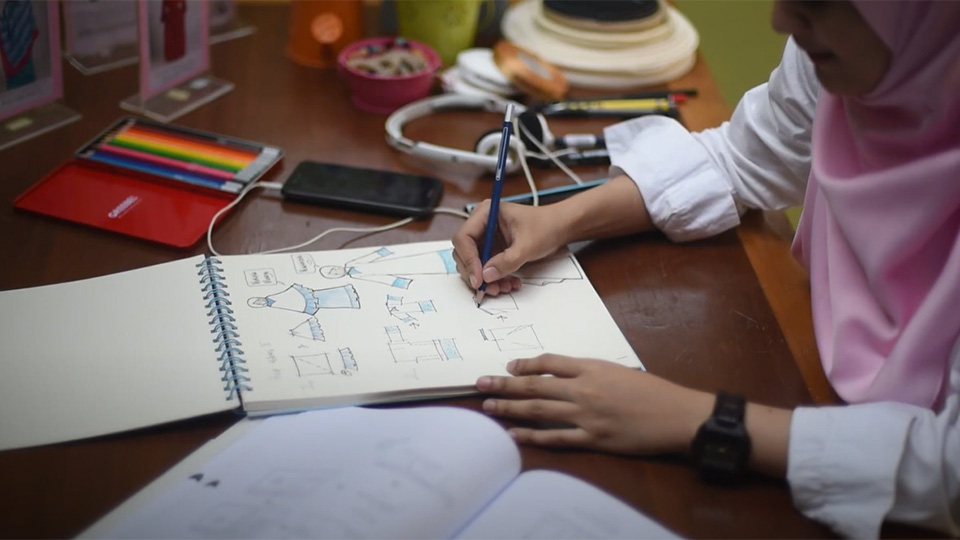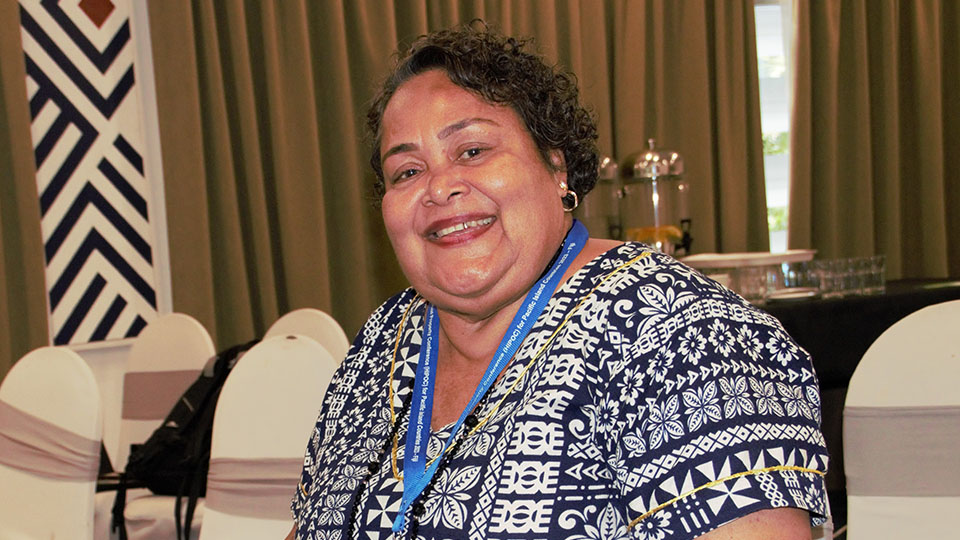Bilum Meri, the Artist Defending an Ancient Craft and the Livelihood of Hundreds of Families
Florence Jaukae Kamel wears many hats: an entrepreneur, a trainer, a fashion designer, a weaver. But the thread that connects all her activities, woven into her life, is as solid as the one used in Papua New Guinea’s ancestral craft that she is fiercely defending: bilums.
Bilum: a versatile bag with many uses
The name bilum has its origins in the Tok Pisin language and means “womb.” It represents the womb of a woman and its primary function was to carry babies, offering them a snug and reassuring embrace. However, bilum bags are versatile, they are used to carry food, whether mumu (cooked food) or fruits and vegetables from the garden or the market to the house. There are bilums for young boys, young girls, men, and traditional healers. Bilums are used to carry bows and arrows for tribal fighting and also serve as headdresses. Florence reinvented the bilum and her creations are now also dresses and traditional outfits.
Jaukae Bilum Products – the avant-garde bilum wear brand
The bilum designer was 6 or 7 years old when her mother taught her how to weave, like many women in Papua New Guinea. She was not really set on being a bilum weaver, but as a single mother of five, she had to support her family and became a commercial weaver.
Florence’s first inspiration was the carpet snake, a local snake with a zigzagged-patterned skin. In 2002, she launched a revolutionary use of bilums by designing bilum dresses and outfits, and founded a fashion design firm: Jaukae Bilum Products. Florence said this innovation led to “a big debate in the country”, with some deeming the move too progressive, and others showing enthusiasm.
Years later, her pioneering step has become mainstream, her dresses worn for celebrations and ceremonial activities, and her unrelenting efforts at promoting and protecting bilums have earned her the name of Bilum Meri (Bilum woman).
Weavers Cooperative, Safeguarding the tradition of Bilum-making
Florence is also the founder and director of the Goroka Bilum Weavers Cooperative, a group of women from all over Goroka, who come together to weave and sell their bilums. Some 100 weavers are members of the cooperative, but in reality, she said, the network is much larger, since each weaver will know five to ten other weavers who might join in. According to Florence, it is safe to say that the cooperative provides sustenance to some 1,000 women throughout Papua New Guinea.
As a bilum trainer, Florence counsels cooperative members on product quality, market research, and national and international market standards. The cooperative also serves to protect the traditional knowledge surrounding bilum-making and to transfer skills from one person to another. “We are sister weavers who are from different bilum communities.” The training improves the quality of bilums, which can then sell better on the national and international markets, helping to secure a fair income, she explained.
Most women in Papua New Guinea become weavers as a means to sustain their family. Some 80 percent of weavers are illiterate, and Florence routinely works with single mothers, women with health problems, and women living in settlements in remote rural areas.
Traditional knowledge, heritage, but also countless hours of work are needed to produce bilums; a very small bag will take between three to five days of work, a standard bag one to two weeks, a medium bag two, three, or four weeks, while a large bag could require five or six weeks of weaving. A dress, such as those designed by Florence takes six to eight weeks of the weaver’s time.
“I basically wear, walk and talk Bilum nearly every day of my life,” Florence said. “I inherited the name Bilum Meri from the People of Papua New Guinea. They just called me Bilum Meri.”
The Goroka Bilum Festival, Celebrating Bilum as a National Treasure
In 2009, Florence along with the Pacific Trade Invest (PTI) founded the Goroka Bilum Festival “to celebrate the national treasure of Bilum.” It was the first cultural event in Papua New Guinea dedicated to women’s practice of Bilum-weaving. The festival has been hugely successful with recent editions attracting over 2,000 people and showcasing the creation of over 200 Bilum weavers from Wewak, Mt. Hagen, Mt. Giluwe, Chimbu, Eastern Highlands, Madang, and Porgera, she proudly said, adding that “it has grown to become a well-recognized platform for Bilums.”

Beyond gathering Bilum weavers, the festival enables Florence to catalog, record and document all the traditional Bilum designs on display “to make sure all the designs are protected, and no one is trying to introduce western influence or steal the designs.” She also gathers stories, legends, poems, and history linked to those designs.
“I also make sure that weavers understand the principle of the designs’ origin, so that they respect others’ creations and original traditional regional designs, and not copy and appropriate them.”
Misappropriation is a constant concern for Florence. “Traditional designs are passed on from generation to generation, local patterns are typical of certain villages, but there are also modern designs, and creative designs. The traditional designs are the ones that are owned by the people of Papua New Guinea,” she said.
For the other designs, “once somebody creates a design, they think they own it but everybody wants to copy it, and if you don’t protect the design, somebody will steal it.” With these words, she neatly sums up the challenge around protecting traditional knowledge as a form of intellectual property (IP), being addressed by WIPO’s program on traditional knowledge, cultural expressions and genetic resources: while the underlying designs are not fully protected for communal benefit, contemporary adaptations by individuals can be protected by conventional intellectual property rights.
The festival also allowed Florence and PTI to identify and secure orders from key international buyers.

Local Efforts to Deter fake Bilums
Bilums are facing increasing pressure as Bilum bags have become popular outside the borders of the country, attracting some foreigners to import Bilums imitations into Papua New Guinea.
On one occasion, once Florence realized that fake Bilums were on sale in a shop, she went in, bought two fake bilums, then threatened the shopkeeper of an imminent onslaught from the public on his shop if he did not remove the fake goods. The harsh tactic worked as a temporary measure until she went to the customs office, explained the situation, and asked for help. The goods were further seized and destroyed by the customs authorities.
The incident made news headlines “It is the biggest thing I did for the country and the women,” she said, adding “I was so fortunate to be a participant in WIPO’s Training, Mentoring and Matchmaking Program for Women Entrepreneurs from Indigenous Peoples and Local Communities, as this gave me the knowledge, support and confidence I needed to handle the intellectual property aspects.” Under the program, steps are being taken to provide Florence with pro bono legal support, pursuant to an agreement between WIPO and the International Trademark Association (INTA).
Reinforcing protection of Bilums through intellectual property and local outreach
Florence said she hoped that the government would further strengthen the copyright laws and reinforce control of this traditional handicraft. She also expressed hope that the government would help weavers to protect their creations. At present, the cost of the trip to the IP office in Port Moresby, and subsequent accommodation needs are simply out of reach of most weavers. Efforts should be deployed to reach weavers everywhere so that they can protect their designs, she said.
In a welcome development, bilums now sold in Papua New Guinea must be weaved in the country, Florence noted, citing government sources.
Younger Generation Brings Changes, Ancient Way Dims
As the younger generation sometimes comes back to the village to learn the craft from their mother, changes are noticeable.
The first change noted by Florence is about designs and destinations as young weavers create modern designs and new objects. She noted with a hint of regret that the adoption by the younger generation of western communication tools and social media has distracted “our daughters… who do not have time to learn the traditional weaving technique or listen to stories, history, and legends behind traditional designs and tribes.”
The second change is seen in the weaving technique of the different kinds of weavers.
Modern weavers, create new items focusing on modern designs that they desire to create after being inspired from an object in the colors that inspire them.
In contrast, traditional weavers can chant and weave or chant and twist. They know stories, legends, history, and songs behind traditional designs and continue to practice the ancient traditional technique. They also take on the responsibility to teach their daughters and nieces to weave.
Commercial weavers are focused on income making. They mostly weave only to sell and are business-minded to sustain their livelihood.



